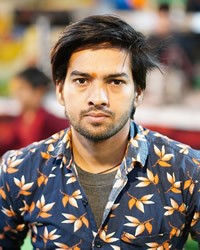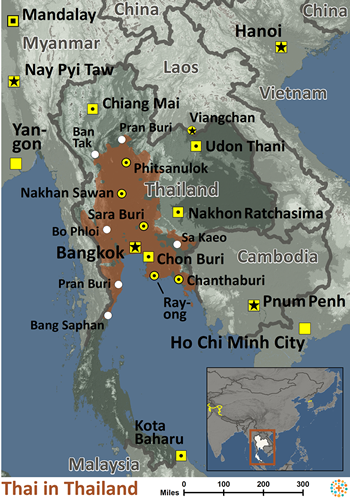Centuries ago the Thai lived north of Yangtzekiang in China. Relentless pressure by the Chinese gradually forced them southward. They conquered many peoples and cultures as they sought a new homeland, and by the 10th century they had settled in Central Thailand. A bloodless revolution in 1932, led by Westernized intellectuals, instituted a democratic constitutional monarchy. However, the country has suffered numerous governmental upheavals since then. Today, Buddhism is the central and unifying force in Thai society and even maintains social control. They speak Thai, the official language of the country.
The Thai are unusually polite, respectful, and hospitable people. Their children are brought up to respect those of a higher rank, with additional emphasis on independence and self-reliance. The Thai seldom use physical punishment to discipline children.
Age is highly respected in Thai society. Type of occupation, wealth, and place and type of residence follow age in terms of respect and rank. Rural farmers rank below artisans, merchants, and city government officials; clergy form a separate group. Families are the core of Thai society. In rural areas, the immediate family usually lives, eats, and farms together. A young married couple may live with the bride's family until they can establish their own home.
The Thai are distinguished by a near absence of labor division by gender. Both men and women plow, till, fish, cook, tend babies, clean house and wash clothes. Rice is the major economic crop, providing both a food staple and a cash crop.
The wealthiest Thai live in wood-framed homes that are raised off the ground and have plank floors, hard wood or mahogany panels, and tile roofs. The poorest villagers live in bamboo homes with thatched roofs and dirt floors. There are a wide variety of homes in the cities: multi-level cement houses, houses that are attached to or above shops, townhouses, apartment complexes, or wooden houses. The temple and school are prominent features in the villages. Water taxis transport people and cargo on polluted waterways that connect houses and other buildings.
Theravada Buddhism was introduced in Thailand in 329 B.C. Almost all of the Thai are devout followers of Buddha ("the enlightened one") and seek to eliminate suffering and improve their future by gaining merit in pursuit of perfect peace, or nirvana. They believe that merit can be acquired through feeding monks, donating to temples, and attending worship services.
Traditionally, young men enter a Buddhist monastery for three months to study Buddhism. The Thai also attempt to incorporate their Buddhist beliefs with folk animism, a practice in which they seek help through the worship of spirits and objects.
Thailand has serious public health problems. Hepatitis is prevalent and malaria is a problem in rural areas. HIV infections are epidemic in the cities.
Prostitution is a pressing social problem. Prostitutes, usually from poor, rural areas are forced to sell their bodies to help their families survive. Education and employment opportunities for women are limited, and many women and children lack adequate health care.
Although a number of mission agencies are working among the Thai, more help is needed. The Bible, the JESUS Film, and audio recordings are all available in the Thai language. The prevailing attitude among Thai Buddhists is that Christianity is fine for Westerners, but Buddhism is what is right for them.
Ask the Holy Spirit to soften the hearts of the Thai towards the ways of Christ.
Ask the Lord to raise up strong local churches that will plant more churches.
Ask God to raise prayer teams who will begin breaking up the soil through worship and intercession.
Pray that God will grant wisdom and favor to mission agencies currently ministering to the Thai.
Ask God to send Christian teachers and medical teams to work among the Thai.
Scripture Prayers for the Thai in Thailand.
https://en.wikipedia.org/wiki/Thai_people#:~:text=Thai%20people%20(also%20known%20as%20Siamese%20people%20and%20by%20various
https://www.worldatlas.com/articles/thailand-customs-beliefs-and-culture.html
| Profile Source: Joshua Project |

























